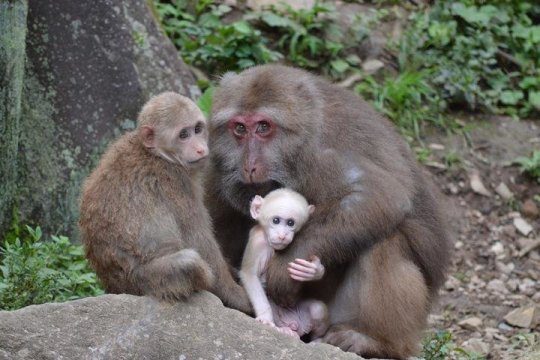[ad_1]
Anyone who peruses relationship settings on social media knows that our interactions with other humans can be intricate, but a new study in Nature: Scientific Reports suggests that researchers may be overlooking some of these same complexities in the social relations of our closest primate relatives, such as chimpanzees and macaques.
“Our study confirms that the social relationships of nonhuman primates are extremely complicated, nuanced and multi-faceted,” said Jake Funkhouser, lead author of the study and an anthropology doctoral student in Arts & Sciences at Washington University in St. Louis.
“It also suggests that existing research techniques for observing and measuring dominance are missing components of complexity that are critical for understanding the layers of diverse social relationships we see in the animal kingdom, our own human societies included,” Funkhouser said.
Primatologists, such as Jane Goodall, Biruté Galdikas and Dian Fossey, have been studying primate behavior for decades, so the idea that chimpanzees and other primates have complex social relationships is nothing new.
While Funkhouser and colleagues affirm the importance of understanding these relationships, they argue that many long-established methodologies for assessing primate power struggles — observations of fighting over food or mates — may be too one-dimensional to capture the very complex social dynamics of primate relationships.
“The social relationships humans share with others cannot be accurately represented in simply ‘dominant’ or ‘subordinate’ terms,” Funkhouser said. “Nor do our relationships readily transfer between settings; the aggressive or confrontational interactions we engage in with some are much different than the prosocial interactions we share with our spouse and best friends.
“Primate social relationships also are highly individualized and dependent on the partners involved and the social setting in which the interaction takes place. As the primate species with the most complex sociality, we humans should understand this pretty well,” he said.
Across the animal kingdom, the term “social dominance” has been widely used as a descriptive shorthand to convey the behavioral characteristics and power status of individual animals and simplify the overall structure of social relationships within groups. However, investigators often differ in their definitions of dominance, the methods used to derive dominance and the statistical techniques used to rank individuals in a group. “This is precisely the problem we set out to explore,” Funkhouser said.
In this study, Funkhouser and colleagues captured detailed behavioral data from the observation of captive chimpanzees at Chimpanzee Sanctuary Northwest in Cle Elum, Wash., and of wild Tibetan macaques of Mt. Huangshan in the Anhui Province of China.
By running these same behavioral data sets through a series of 69 different statistical analyses, they were able to compare and contrast how various methodologies ranked individuals’ status and how these structures of dominance predicted patterns of other social behavior within the groups.
“When distilled, this paper simply highlights something intuitive about what being dominant means for a social animal: that social context matters,” said co-author Jessica A. Mayhew, director of the Primate Behavior and Ecology program and assistant professor of anthropology and museum studies at Central Washington University in Ellensburg, Wash.
“The perception that dominance is solely about aggression, in other words who ‘wins’ and who ‘loses’ a contest, is only one piece of the larger group social dynamics,” Mayhew said. “It’s critical that as researchers we continue to acknowledge the context in which we collect our data because it influences our interpretation.”
To exemplify this, at Chimpanzee Sanctuary Northwest, this study found that Jamie, an adult female chimpanzee who was retired from biomedical research, directs a lot of aggression toward the other chimpanzees. Therefore, through a competitive lens, Jamie is calculated to be the most dominant.
However, Negra — an older adult female chimpanzee who was captured in the wild as an infant, used in biomedical research and then retired — rarely engages in aggressive interactions but is most frequently the recipient of the groups’ grooming efforts.
In Negra’s case, she was calculated to be most dominant via the occupation of a privileged, or “respected,” role in the group. These different results correspond with observations of chimpanzees’ extremely complex and fluid social systems in the wild.
On the other hand, wild Tibetan macaques are often observed to have much stricter social rules, and this study picked up on those trends as well. These macaques follow species-typical trends and maintain one, mostly generalizable, dominance hierarchy that is stable across social contexts.
For example, young adult males TouGui and YeRongBing along with GouShan, a much older male, occupy the top of the dominance hierarchy, while females YeZhen, TouRongYu and TouTai occupy the bottom of the hierarchy.
Funkhouser, who studied primate behavior under Mayhew while pursuing his undergraduate and master’s degrees at Central Washington University, is conducting his doctoral research under the supervision of Crickette Sanz, an associate professor of physical anthropology at Washington University.
Sanz is a leading scholar of primate behavior and co-principal investigator of the Goualougo Triangle Ape Project in the northern Republic of Congo.
In Funkhouser’s doctoral work, he and Sanz plan to continue asking questions of behavioral adaptations, comparative social behavior and individual welfare of chimpanzee populations living in the wild, zoos and sanctuaries.
“Power dynamics among primates can have life or death outcomes; being an alpha can mean that a primate has access to higher quality food or more mates. The study of animal social relationships has been transformed over the past decade by a suite of new methods and analytical tools,” Sanz said. “This study shows how these tools can be used to better understand social relationships among chimpanzees and macaques, two species with reputations for being highly political.”
[ad_2]















